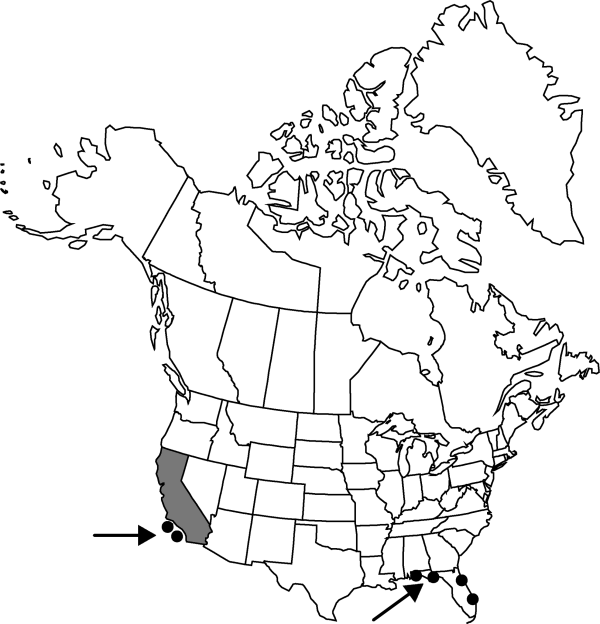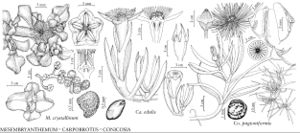Difference between revisions of "Carpobrotus edulis"
in E. P. Phillips, Gen. S. Afr. Fl. Pl., 249. 1926.
FNA>Volume Importer |
imported>Volume Importer |
||
| (One intermediate revision by the same user not shown) | |||
| Line 1: | Line 1: | ||
{{Treatment/ID | {{Treatment/ID | ||
|accepted_name=Carpobrotus edulis | |accepted_name=Carpobrotus edulis | ||
| − | |accepted_authority=(Linnaeus) N. E. Brown | + | |accepted_authority=(Linnaeus) N. E. Brown |
|publications={{Treatment/Publication | |publications={{Treatment/Publication | ||
|title=in E. P. Phillips, Gen. S. Afr. Fl. Pl., | |title=in E. P. Phillips, Gen. S. Afr. Fl. Pl., | ||
| Line 8: | Line 8: | ||
}} | }} | ||
|common_names=Hottentot-fig | |common_names=Hottentot-fig | ||
| + | |special_status={{Treatment/ID/Special_status | ||
| + | |code=I | ||
| + | |label=Introduced | ||
| + | }}{{Treatment/ID/Special_status | ||
| + | |code=F | ||
| + | |label=Illustrated | ||
| + | }} | ||
|basionyms={{Treatment/ID/Basionym | |basionyms={{Treatment/ID/Basionym | ||
|name=Mesembryanthemum edule | |name=Mesembryanthemum edule | ||
| Line 30: | Line 37: | ||
|elevation=0-100 m | |elevation=0-100 m | ||
|distribution=Calif.;Fla.;Mexico (Baja California);South America (Chile);Europe;s Africa;Pacific Islands (New Zealand);Australia. | |distribution=Calif.;Fla.;Mexico (Baja California);South America (Chile);Europe;s Africa;Pacific Islands (New Zealand);Australia. | ||
| + | |introduced=true | ||
|discussion=<p><i>Carpobrotus edulis</i> is extensively planted in gardens and along highways and is also used for dune and bluff stabilization. An invasive, introduced species escaped from cultivation, <i>C. edulis</i> hybridizes with other <i>Carpobrotus</i> species. According to W. Wisura and H. F. Glen (1993), pink-flowered plants are seen in the wild only when <i>C. edulis</i> comes in contact with species of <i>Carpobrotus</i> with purple flowers.</p> | |discussion=<p><i>Carpobrotus edulis</i> is extensively planted in gardens and along highways and is also used for dune and bluff stabilization. An invasive, introduced species escaped from cultivation, <i>C. edulis</i> hybridizes with other <i>Carpobrotus</i> species. According to W. Wisura and H. F. Glen (1993), pink-flowered plants are seen in the wild only when <i>C. edulis</i> comes in contact with species of <i>Carpobrotus</i> with purple flowers.</p> | ||
|tables= | |tables= | ||
| Line 39: | Line 47: | ||
-->{{#Taxon: | -->{{#Taxon: | ||
name=Carpobrotus edulis | name=Carpobrotus edulis | ||
| − | |authority=(Linnaeus) N. E. Brown | + | |authority=(Linnaeus) N. E. Brown |
|rank=species | |rank=species | ||
|parent rank=genus | |parent rank=genus | ||
| Line 53: | Line 61: | ||
|publication title=in E. P. Phillips, Gen. S. Afr. Fl. Pl., | |publication title=in E. P. Phillips, Gen. S. Afr. Fl. Pl., | ||
|publication year=1926 | |publication year=1926 | ||
| − | |special status= | + | |special status=Introduced;Illustrated |
| − | |source xml=https:// | + | |source xml=https://bitbucket.org/aafc-mbb/fna-data-curation/src/2e0870ddd59836b60bcf96646a41e87ea5a5943a/coarse_grained_fna_xml/V4/V4_179.xml |
|genus=Carpobrotus | |genus=Carpobrotus | ||
|species=Carpobrotus edulis | |species=Carpobrotus edulis | ||
Latest revision as of 21:57, 5 November 2020
Stems to 3 m; bark persistent, leathery. Leaves green; blade sharply 3-angled in cross section, widest proximal to middle, adaxial side concave, outer angle serrate near apex, 5–11 × 1–1.5 cm. Inflorescences: pedicel 20–60 mm. Flowers 8–10 cm diam.; calyx lobes 10–60 mm; outer 2 lobes sharply 3-angled in cross section, abaxial angle serrate near apex, 30–60 mm; inner 3 lobes smaller, with membranous margins; petals (including petaloid staminodia) 100–200, yellow, aging pink, 2–4(–5)-seriate, 30–40 mm; stamens 100 per series, yellow, 4(–7)-seriate, simple to plumose, 6–8(–12) mm; anthers yellow; stigmas radiating out over fruits, 8–15 mm. Fruits yellowish, clavate to subglobose, depressed apically, 20–35 mm. Seeds ca. 1000. 2n = 18.
Phenology: Flowering year-round, mostly spring.
Habitat: Coastal dunes, bluffs and terraces, margins of estuaries
Elevation: 0-100 m
Distribution

Introduced; Calif., Fla., Mexico (Baja California), South America (Chile), Europe, s Africa, Pacific Islands (New Zealand), Australia.
Discussion
Carpobrotus edulis is extensively planted in gardens and along highways and is also used for dune and bluff stabilization. An invasive, introduced species escaped from cultivation, C. edulis hybridizes with other Carpobrotus species. According to W. Wisura and H. F. Glen (1993), pink-flowered plants are seen in the wild only when C. edulis comes in contact with species of Carpobrotus with purple flowers.
Selected References
None.
